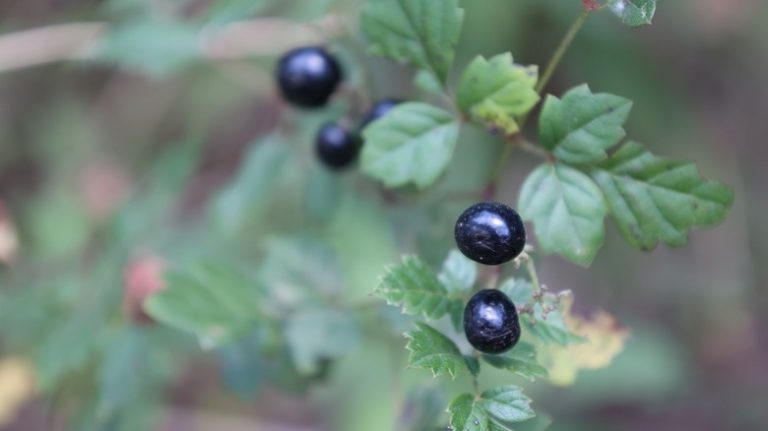There’s nothing like the smell of fresh mulch to make an avid gardener’s heart pitter patter with excitement. Why? It signals the beginning of the growing season. So whether you buy it in bags from the gardening center or get a whole truckload delivered to your house, the first whiff of that woody, organic aroma is unmistakable. And besides the initial sensory experience, mulch actually provides a plethora of benefits for your garden.
A healthy layer of mulch (we’ll cover just how much to use later on) slows weed growth, which translates into fewer hours of backbreaking weed-pulling and maintenance for you. Additionally, the Water Conservation for Lawn and Landscapes says it protects your plants from water loss by shading the soil (which prevents evaporation) and guarding the delicate roots from hot, dry conditions or sudden drops to colder temperatures. Mulch also packs a punch in the aesthetics department, as a fresh layer tidies up the appearance of your garden, keeps plants looking their best, and maximizes your curb appeal.
What are the different types of mulch?
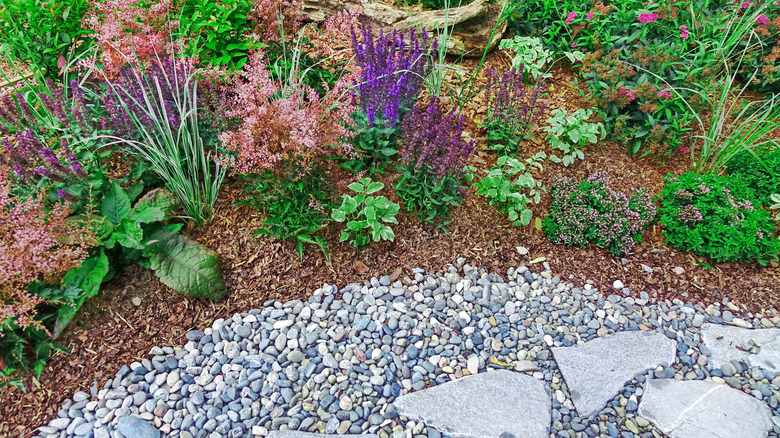
If you’re a beginner gardener, it’s normal to feel overwhelmed by all the different types of mulch available at your local garden center. But let’s break it down: For starters, the variety of mulch you choose will either be organic or inorganic. Now, within these two categories are lots of subcategories and spinoffs.
Organic mulch is an excellent choice for your garden because it provides nutrients to the soil as it slowly decomposes. The most common types of organic mulch are wood chips and shredded bark. However, other organic options include grass clippings, straw, leaves, compost, and pine needles, according to Good Housekeeping. Wood chips are most commonly used for flower beds or other prominent planting displays, as they provide an attractive, crisp appearance. Straw and grass clippings are great choices for vegetable gardens.
Inorganic mulch doesn’t decompose and therefore lasts a lot longer than organic mulch. If you want to save money in the long run or not worry about reapplying a layer each year, inorganic might be the best choice for you. Your options in this category include rocks (stones or lava rocks), landscape fabric, or chopped up rubber. Bob Vila says that rocks are a great option for lining paths or walkways, but they’re not the best choice to use around plants because their heat absorption and retention can actually burn or damage your plants.
When and where to apply mulch
Though the exact timing depends on the climate where you live, it’s a good rule of thumb to lay your mulch in mid-to-late spring, says Martha Stewart. You don’t want to do it earlier than this, because a thick layer of mulch will prevent the soil from adequately thawing and warming up after a cold winter — and your soil needs to be warm in order to best support plant life. An exception to this timeline is if you have perennials that’ll begin blooming in the spring. Your best bet is to mulch around them when they’re dormant. Check the care instructions for any perennials you have to make sure you mulch at the appropriate time.
You can spread mulch throughout your flower beds, shade gardens, and veggie patches. When it comes to trees or shrubs, Good Housekeeping urges caution before you pile it on. Too much mulch around a tree’s trunk or the base of a shrub can cause root rot and also provide a perfect spot for rodents to nest. If you’re adamant about placing mulch around your trees/shrubs, Good Housekeeping suggests laying your mulch six to 12 inches away from the tree trunk or shrub base.
How much mulch should you use?
Shutterstock
Even though mulch is a wonderful addition to your garden, too much of it can negate all of the benefits and wind up harming your plants. Not sure how much to spread in order to reap the benefits but not suffocate the flowers? Country Living suggests an even depth of two inches across the garden bed. Depending on the type of mulch you’re using, you might be able to get away with a little more. Varieties like pine bark nuggets don’t impede airflow as much as traditional mulch, so you can increase to depths around four inches.
Now that you know how deep to spread your mulch, you need to determine the total quantity to buy to cover all of your gardening needs. Because you buy mulch by the cubic yard, Country Living offers a formula to figure out how much you need to buy. (Who knew you’d use math equations in gardening?) First, calculate the square footage of your garden bed or area you’re mulching. Then, multiply your square footage by the desired depth of mulch, and then divide by 324. This will give your cubic yard requirements, and then you can head straight to the nursery to buy as much mulch as you need.
Mulch can help you combat weeds
Shutterstock
As previously mentioned, mulch is a highly-effective barrier in your battle against weeds. It blocks sunlight from reaching the weeds, so in turn the seedlings don’t have enough energy to push through the barrier and reach the surface. However, mulch can’t stop every single weed in its path, especially pesky dandelions (compliments of all those fluffy seed heads).
However, there are some things you can do to optimize weed resistance. For starters, before you spread any mulch, pull all the weeds in your garden bed. It’s important to remove the entire root of the weed, or else it will pop right back up. The best time to remove weeds? Try to do it after a heavy rain so that the ground is saturated and your task will be much easier.
Fine Gardening says that crickets and carabid beetles can live in organic mulch and these critters will search for — and eat — various weed seeds. This means less work for you and full bellies for them!
Does the color of mulch matter?
Shutterstock
The color of mulch you choose tends to come from personal preference and how the color will enhance what you’re planting. But aesthetics aside, does the color of mulch matter? Is there any correlation between a certain shade and its performance?
Some people fear that dyed mulch will be bad for their soil. Gardening Know How says this can be true to an extent, and advises gardeners to avoid buying ultra-cheap mulch. The reasoning is that cheap dyes (found in some inexpensive mulch) can contain harmful chemicals which will then seep into the soil and negatively impact your plants.
Colored mulch can also be a popular choice because plain (non-dyed) organic mulch usually fades to a grayish hue after about a year, says Family Handyman – and your plants may not look as vibrant against the subdued gray mulch. However, dyed mulch may keep earthworms away from your garden; they don’t like the chemicals it releases into the soil. Since earthworms are a critical part in every healthy garden ecosystem, you may want to choose an organic, non-dyed mulch to ensure the earthworms stick around.
Steps to take before laying down mulch
Ray Geiger/Shutterstock
When you’re ready to get mulching, first gather your supplies. Gardening gloves are recommended, especially if the much you purchased contains fertilizer or pesticides. For added safety, consider a face mask and, for added comfort, consider a knee pad. You’ll also want a rake and a trowel. Now it’s time to weed.
We can’t overestimate the importance of weeding before mulching. Per ChromaScape, if you use an herbicide to kill the weeds, you’ll need to give it two weeks to finish the job before covering the soil with mulch. ChromaScape also advises trimming and removing any debris or decaying branches from nearby trees and then raking through your dirt to clean up anything that fell.
Aerating the soil is the next step. If you have a hand-operated cultivator, go ahead and use it; a trowel and some elbow grease can work just as well. Oregon State University warns against tilling wet soil, or you risk compacting it or making it clumpy. No need to go overboard here; just loosen it up so air and moisture can make their way in. When you’re done, give the soil one more pass with the rake to even out the surface. Then, top it off with a pre-emergent herbicide as a final step. This is one last measure against weed seeds that may have been left behind. You don’t want them growing under the mulch and robbing the soil of nutrients.
Is it okay to put new mulch over old mulch?
Stockcreations/Shutterstock
The beauty of organic mulch is that, just like all organic matter, it breaks down over time and becomes part of the soil and part of the cycle of all life. This can take as much as five or six years, and in the meantime, you may wonder if you have to rake it up before applying a new layer. More often than not, you can leave the old mulch in place and spread fresh mulch over it in the spring as it decomposes and becomes too thin or leaves bare spots.
Simplify Gardening suggests checking for a few potential issues to ensure your current layer of mulch isn’t causing any problems. For instance, if you had any diseased plants during the previous seasons or saw any signs of fungal infection, you should remove the old mulch and start anew. If the mulch has disintegrated into a mat-like covering, it may hinder plant growth by blocking access to necessary water and oxygen.
Old mulch in decent shape can be mixed with compost to create a healthy, nutrient-dense layer of topsoil. And if you want to leave what’s there alone and top it off to freshen up the look, you should feel comfortable doing just that.
Do you need to mulch in the fall?
Konstantin Zibert/Shutterstock
There are good reasons to mulch in the fall as well as good reasons to skip the practice altogether. HGTV offers great advice to determine what’s best for your yard. Some gardeners will mulch in the fall simply to get it done so they don’t have to worry about it in the spring. It’s also a great excuse to spend more time outside in the crisp, cool autumn air, and it gives you just a few more moments of peace in the garden before the snow starts to fall.
The true benefits of fall mulching include keeping the underground house warmer for all the busy earthworms and microbes hard at work down there, and diminishing the severe freezing and thawing patterns in the soil that can do significant damage to the remaining plant roots of your perennials.
On the flip side, refrain from this practice if you have a large number of self-seeding plants because the mulch will inhibit germination. Also, keep in mind that you’ll need to severely cut back your perennials to apply late-season mulch, so if you don’t want to do that, you should skip it.
Should you water mulch?
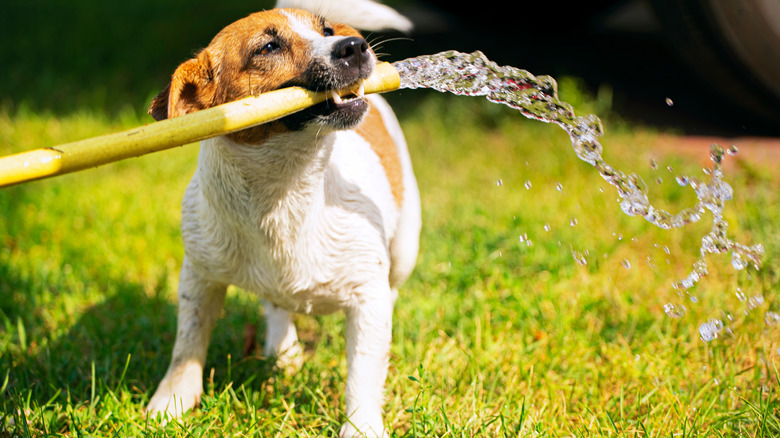
Namaki/Shutterstock
If one of the main points of adding mulch to a garden is to retain moisture, does that mean you need to water it or not? Great question. The short answer is yes, but less often. Eco Family Life explains that when you first lay down a bag of mulch, the material will be light and dry, making it easy to blow away. Initially, you’ll want to water the area pretty heavily. This allows enough water to seep into the roots while leaving some extra water for the mulch to soak up and retain.
For seedlings, keep up a daily watering routine. Over time, however, your plants will require less and less watering because the mulch will hold moisture in and slowly release it. Water will also be retained in the soil because the covering will stop it from evaporating from the surface. In the long run, mulch will help you save water because you won’t be using so much of it, but keeping it sufficiently and evenly moist is still important.
Where to shop for mulch and what to look for
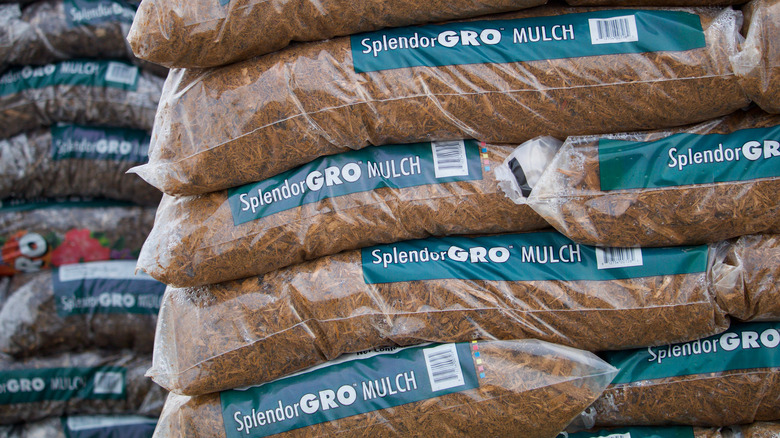
Les Weber/Shutterstock
When considering where to shop for mulch, first try to get a rough calculation of how much you’ll need since this will determine whether you can bring it home in one trip or if it would be better to have it delivered to your house. Gardening Solutions from the University of Florida explains that the standard recommended depth of your mulch layer is 3 inches. For that, you can expect 1 cubic yard to cover an area that is 10 feet by 10 feet, or 100 square feet. Per The Mulch Yard, that translates to roughly 13 bags from your local garden center. If that’s too much to fit in your trunk or the bed of a borrowed pick-up truck, large stores like The Home Depot offer next-day delivery options.
You could also order in bulk. The Mulch Yard claims this is often less expensive and comes with options to not only get the product delivered, but also to have it spread around your yard. You can expect to pay anywhere from $17 to $68 per cubic yard (via LawnStarter). That’s a pretty wide range that will be affected by several factors, including which type of material you choose, which color you’re looking for, whether you purchase it by the bag at a big box store or in bulk from a local vendor, and potential delivery fees.
Common mistakes people make when mulching
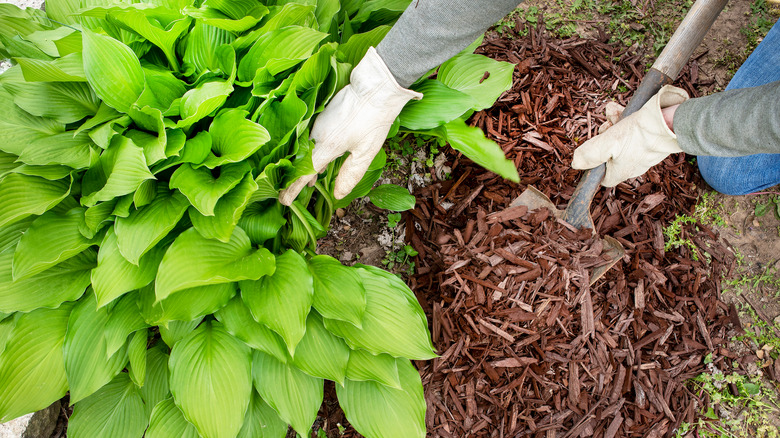
Jon Rehg/Shutterstock
The most common mistakes people make when mulching include doing it at the wrong time of year, using too much, and choosing the wrong kind of material. To begin with, Backyard Boss says it’s best to lay down your mulch in the spring. This will help prevent weeds from growing and retain moisture so your young seedlings can grow into healthy, mature plants.
Over-mulching can create too thick a barrier, which won’t allow any oxygen or water to seep into it. Similarly, spreading the mulch too close to the plants is another common mistake, but for a different reason. Mulch is so good at retaining moisture it can actually lead to stem and root rot when it surrounds the base of a plant; leave 2 inches of space around each stem uncovered for proper airflow and drainage.
When it comes to quantity, a 3-inch layer is more than enough; in fact, 2 inches will probably suffice. Most gardeners and landscapers opt for wood chips as their go-to natural material. It’s important to use organic matter — leaves and grass clippings can be equally effective — and refrain from using plastic or just a pile of rocks.


